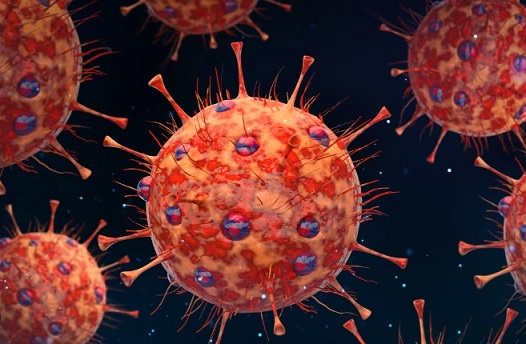SARS-CoV-2 Spike Protein Fragment Known as P3 Peptide Found to Trigger Dangerous T-Cell Overactivation
Nikhil Prasad Fact checked by:Thailand Medical News Team Jun 15, 2025 6 months, 3 weeks, 18 hours, 12 minutes ago
Thailand Medical News: A team of international scientists has uncovered a hidden feature of the SARS-CoV-2 virus that could help explain why severe COVID-19 cases trigger runaway inflammation and immune system overdrive. Researchers from Université de Montréal (Canada), Centre de Recherche-Hôpital Maisonneuve-Rosemont (Canada), McGill University Health Centre (Canada), and Mohammed V University in Rabat (Morocco) have identified a tiny fragment of the virus’s spike protein—dubbed the P3 peptide—that acts like a superantigen, massively overstimulating immune cells.
 SARS-CoV-2 Spike Protein Fragment Known as P3 Peptide Found to Trigger Dangerous T-Cell Overactivation
SARS-CoV-2 Spike Protein Fragment Known as P3 Peptide Found to Trigger Dangerous T-Cell Overactivation
Superantigens are notorious for triggering conditions like toxic shock syndrome. They are molecules that bypass the usual safety checks in the immune system and activate an overwhelming number of T-cells all at once. This can lead to the release of vast amounts of inflammatory chemicals called cytokines, which damage tissues and organs. This
Thailand Medical News report explores how this newly identified SARS-CoV-2 spike protein fragment could mimic this dangerous process.
A Viral Peptide That Behaves Like a Superantigen
In this new study, the researchers identified a specific region in the S2 subunit of the spike protein that shares similarities with known bacterial superantigens like staphylococcal enterotoxins B and H (SEB and SEH). Using advanced computer modeling, they found that this region—named P3—binds tightly to T-cell receptors (TCRs) and molecules called MHC class I and II, just like SEB and SEH do.
Further experiments showed that this small peptide could activate between 25% to 40% of human T-cells in laboratory tests. This is an unusually high percentage, as normal immune responses to pathogens only activate a tiny fraction of T-cells. P3 caused T-cells to enter repeated rounds of cell division and to produce powerful molecules like interferon-gamma (IFN-γ) and granzyme B, both of which are involved in killing infected cells and amplifying immune responses.
Evidence from Mouse Models and Blood Tests
When tested in mice, P3 also triggered the release of three major proinflammatory cytokines—IL-6, IL-1β, and TNF-α—which are all strongly associated with the deadly “cytokine storm” seen in some COVID-19 patients. Compared to controls, mice injected with P3 showed higher levels of these cytokines in their spleen and blood. The peptide also expanded specific subsets of CD8+ and CD4+ T-cells and increased memory T-cell populations.
Interestingly, the researchers also discovered that the P3 peptide shares similarities with certain proteins found naturally in human cells—especially those related to cancer and inflammation. This raises the possibility that similar endogenous peptides might contribute to autoimmune diseases by causing unintended T-cell activation.
Selective Expansion of TCR Chains Confirms Superantigen Behavior
The study included a deep dive into the T-cell receptor (TCR) repertoire of P3-stimulated cells. It revealed that P3 selectively expanded a small number of TCR Vα and Vβ chains, a hallmark of superantigen activity. In total, 138,538 TRAV and 94,767 TRBV clonotypes were found after P3 exposure, confirming an unusually diverse T-cell response.
Moreover, the peptide induced expression of key activation markers like CD69 and Ki67, with strong effects seen in both CD4+ and CD8+ T-cell subsets. This level of immune system activation, the researchers caution, could not only worsen COVID-19 but may also create a foundation for future autoimmune complications.
Conclusion
This landmark discovery sheds new light on how a hidden sequence in the SARS-CoV-2 spike protein could be mimicking bacterial superantigens to wreak havoc on the human immune system. By overstimulating T-cells and triggering massive inflammatory responses, the P3 peptide might be a missing link explaining why some people experience severe COVID-19 or develop lingering symptoms afterward. These findings also hint that parts of the virus may be playing a role in long-term immune dysfunction and autoimmunity—concerns that warrant further urgent research.
The study findings were published in the peer reviewed journal: Communications Biology.
https://www.nature.com/articles/s42003-024-07350-8
For the latest COVID-19 News, keep on logging to
Thailand Medical News.
Read Also:
https://www.thailandmedical.news/news/breaking-spike-protein-found-in-brain-arteries-long-after-covid-19-mrna-vaccination-raises-global-health-fears
https://www.thailandmedical.news/news/italian-scientist-warn-that-sars-cov-2-spike-proteins-kills-brain-cells-directly-via-necroptosis
https://www.thailandmedical.news/news/scientists-from-finland-warn-that-sars-cov-2-may-trigger-cancer-in-a-manner-similar-to-other-oncogenic-viruses
https://www.thailandmedical.news/articles/coronavirus
